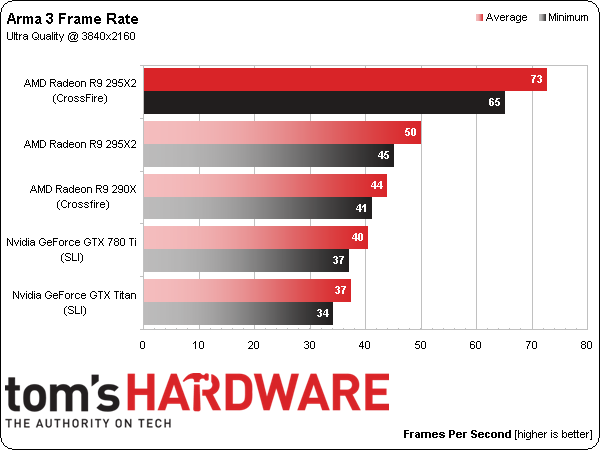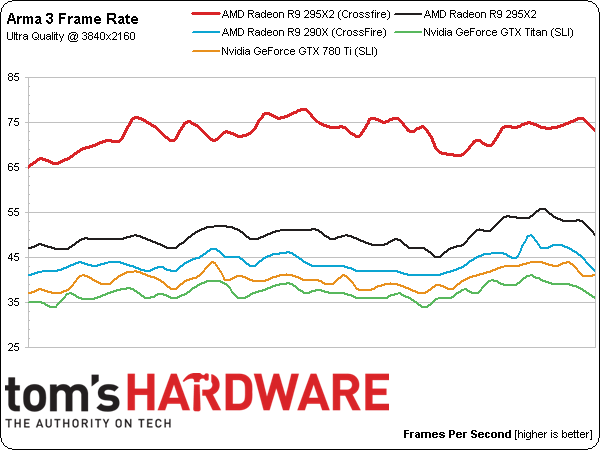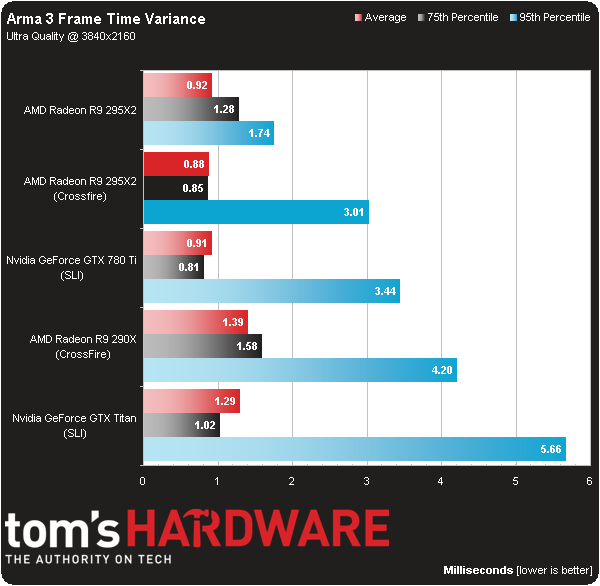Update: Radeon R9 295X2 8 GB In CrossFire: Gaming At 4K
We spent our weekend benchmarking the sharp-looking iBuyPower Erebus loaded with a pair of Radeon R9 295X2 graphics cards. Do the new boards fare better than the quad-GPU configurations we've tested before, or should you stick to fewer cards in CrossFire?
Results: Arma 3
FCAT says Arma 3 averages 73 FPS on a pair of Radeon R9 295X2s; Fraps says 72 FPS. I’d say that’s pretty close to a consensus.
This chart reflects performance a fair bit higher than what was original reported. Previously, scaling was around 20%. Here, it’s 46%. We can’t say for sure why the new number is so much higher. However, all of the benchmarks going into today’s piece are run with the side of our Erebus test platform’s side panel off, allowing maximum airflow.
Why? As it turns out, the Hawaii GPUs on AMD’s Radeon R9 295X2 have a 75 °C limit necessitated by the liquid cooling hardware. It’s not hard to trigger throttling using a workload like GUIMiner. However, it’s probable that the closed case and heat runs we used in the original version of this piece forced performance in Arma down as well.
We’ll keep an eye out for similar behavior as the evaluation continues. Although you wouldn't use a pair of Radeon R9 295X2s like this in the real-world, AMD is also clear that its radiators need to be set up in a specific way for optimal thermal performance, and company reps say that wasn't the case for the system we initially reviewed.
The hypothesis is bolstered by a far less frenetic frame rate over time chart (the original looked like this). Instead, two Radeon R9 295X2s sustain their performance for longer, nosing up over 75 FPS, and not dropping below 65.
Frames are delivered more smoothly as well, and a pair of 295X2s only trail the individual dual-Hawaii board in worst-case frame time variance.
The twin 295X2s are plagued by a handful of frame time variance spikes that are noticeable on-screen, but behave themselves otherwise.
Get Tom's Hardware's best news and in-depth reviews, straight to your inbox.
Arma 3 isn’t one of the games we originally took issue with. It makes sense then, that the results on this page don’t flavor our ultimate opinion much. We’re glad to measure additional performance in a best-case cooling/airflow scenario. And if this game is the only one you’re worried about playing, $1500 might be worth an extra 40-something-percent performance.
Let’s leave the editorialization there for now and continue on with the hard numbers.
Current page: Results: Arma 3
Prev Page Radeon R9 295X2s, Working Together Next Page Results: Assassin’s Creed IV-
redgarl I always said it, more than two cards takes too much resources to manage. Drivers are not there either. You are getting better results with simple Crossfire. Still, the way AMD corner Nvidia as the sole maker able to push 4k right now is amazing.Reply -
BigMack70 I personally don't think we'll see a day that 3+ GPU setups become even a tiny bit economical.Reply
For that to happen, IMO, the time from one GPU release to the next would have to be so long that users needed more than 2x high end GPUs to handle games in the mean time.
As it is, there's really no gaming setup that can't be reasonably managed by a pair of high end graphics cards (Crysis back in 2007 is the only example I can think of when that wasn't the case). 3 or 4 cards will always just be for people chasing crazy benchmark scores. -
frozentundra123456 I am not a great fan of mantle because of the low number of games that use it and its specificity to GCN hardware, but this would have been one of the best case scenarios for testing it with BF4.Reply
I cant believe the reviewer just shrugged of the fact that the games obviously look cpu limited by just saying "well, we had the fastest cpu you can get" when they could have used mantle in BF4 to lessen cpu usage. -
Matthew Posey The first non-bold paragraph says "even-thousand." Guessing that should be "eleven-thousand."Reply -
Haravikk How does a dual dual-GPU setup even operate under Crossfire? As I understand it the two GPUs on each board are essentially operating in Crossfire already, so is there then a second Crossfire layer combining the two cards on top of that, or has AMD tweaked Crossfire to be able to manage them as four separate GPUs? Either way it seems like a nightmare to manage, and not even close to being worth the $3,000 price tag, especially when I'm not really convinced that even a single of those $1,500 cards is really worth it to begin with; drool worthy, but even if I had a ton of disposable income I couldn't picture myself ever buying one.Reply




